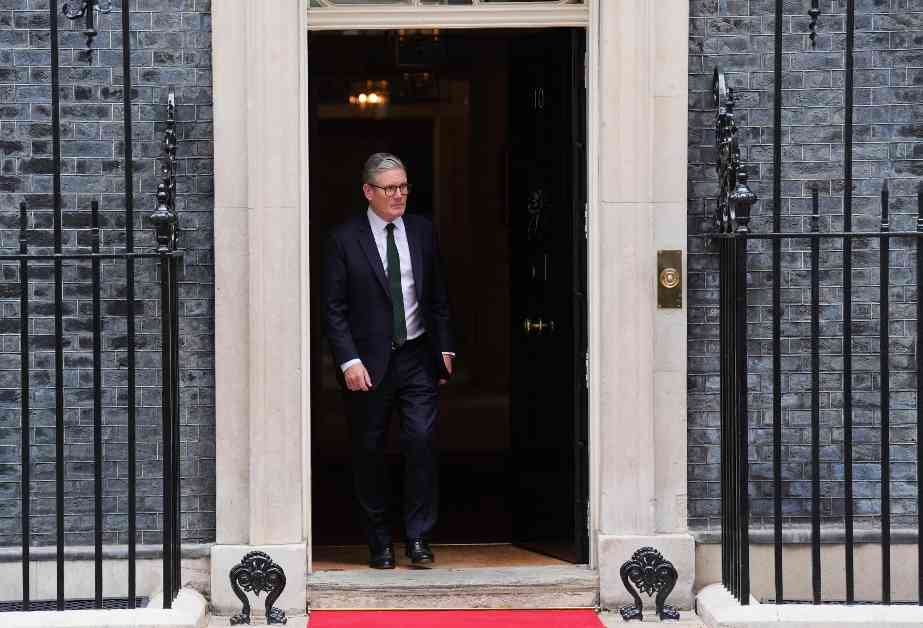Conservatives have accused Sir Keir Starmer of “petty” behavior after a portrait of Margaret Thatcher was removed from Downing Street. The new Labour Prime Minister decided that the “unsettling” picture had to go as he embarked on a round of redecoration after moving into his new home. The Herald exclusively revealed the news on Thursday, but the story is now breaking across the country with Tory tanks outraged at the sudden defenestration of their late idol.
Sir Keir has been dubbed “churlish” and “disappointing” for getting rid of the portrait, with one national newspaper accusing him of “petty vindictiveness.” The decision to remove the Thatcher portrait has sparked a debate on whether it was the right move to break from the past or if Sir Keir should have honored history by keeping the painting of the divisive former Prime Minister on the wall.
The portrait of Margaret Thatcher was commissioned by Gordon Brown in 2007 when she visited him for tea at No 10, a few months into his premiership. It was painted by royal artist Richard Stone, with an anonymous donor stumping up the £100,000 cost. When it was unveiled in 2009, it was hung in the former No 10 study, unofficially known as the Thatcher Room, which, at the time, was used by Mr. Brown for meetings with foreign dignitaries.
### The Debate Over the Removal
The decision to remove the portrait of Margaret Thatcher from No 10 Downing Street has ignited a fiery debate between political parties and the public. Conservatives have criticized Sir Keir Starmer for what they perceive as a disrespectful act towards a former Prime Minister who played a significant role in shaping the country’s history. On the other hand, supporters of Sir Keir argue that it is his prerogative as the current Prime Minister to choose the decor of his residence and that removing the portrait is a symbolic gesture of moving forward from divisive politics.
The debate has highlighted the polarizing legacy of Margaret Thatcher, with some viewing her as a transformative leader who brought about much-needed economic reforms, while others remember her tenure as a time of deep social division and hardship. The removal of the portrait has reignited discussions about how we remember and commemorate historical figures, particularly those who elicit strong emotions and differing opinions.
### Symbolism vs. Tradition
The act of removing a portrait from a prominent location like No 10 Downing Street is not merely a matter of interior decor but carries significant symbolic weight. The presence of Margaret Thatcher’s portrait in the Thatcher Room served as a reminder of her time in office and her impact on British politics. By choosing to remove the portrait, Sir Keir Starmer has signaled a break from the past and a shift in the narrative of his administration.
For some, the removal of the portrait represents a rejection of Thatcherism and a commitment to a different set of values and policies. It is seen as a statement of intent to move away from the policies and ideologies associated with Thatcher’s era and forge a new path for the country. However, for others, the removal of the portrait is seen as erasing history and dishonoring the legacy of a Prime Minister who left a lasting impact on the nation.
### Historical Context and Public Perception
The decision to remove the portrait of Margaret Thatcher must be viewed in the context of her legacy and the public’s perception of her time in office. Thatcher’s tenure as Prime Minister was marked by significant economic reforms, privatization of state-owned industries, and a confrontational approach to trade unions. While she is celebrated by some for revitalizing the economy and standing up to the Soviet Union during the Cold War, others remember her as a divisive figure who implemented policies that disproportionately affected working-class communities.
The public’s perception of Margaret Thatcher is deeply polarized, with supporters lauding her as a strong and decisive leader, while critics condemn her for exacerbating inequality and social division. The removal of her portrait from No 10 Downing Street reflects the ongoing debate over how we remember and commemorate historical figures, particularly those whose legacies are contested and evoke strong emotions.
### Conclusion
In conclusion, the decision to remove the portrait of Margaret Thatcher from No 10 Downing Street has sparked a contentious debate about the legacy of the former Prime Minister and the symbolism of historical commemoration. While some view the removal as a necessary step towards moving forward from divisive politics and embracing a new era of governance, others see it as a disrespectful act that erases history and dishonors the memory of a significant political figure.
The debate over the removal of the portrait reflects deeper divisions within society about how we remember and commemorate our past, particularly when it comes to controversial figures like Margaret Thatcher. As the discussion continues to unfold, it is crucial to consider the complexities of historical memory and the importance of acknowledging different perspectives in shaping our understanding of the past.
































